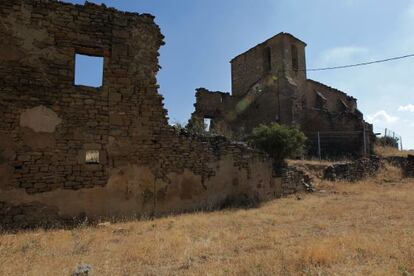Why the bishops are turning their backs on churches in ruins
Tensions over ownership and maintenance are nothing new


The Church doesn't want ruins. The problem lies in that they don't bring in any funds - quite the opposite, in fact. The Archbishopric of Navarre has returned to the municipality of Leoz three churches that it had in its name, in exchange for a cancellation of its debt to the council, which amounted to 45,000 euros.
It's a peculiar solution, whereby the council ends up with what are, basically, three ruins.
The council represents 12 villages and one señorío (fiefdom), but, in a region of rural depopulation, the inhabitants number less than 300. One day, the decision was taken to survey the condition of all the buildings in the municipality; several were found to be ruinous. Some were in private hands, while others belonged to the council itself, and several to the Church.
"All were informed of what they had to do," says the mayor, Ramón Muruzábal. "Firstly, fence them in, for safety reasons; and then we asked for suitable solutions to be sought. Everyone did what had to be done, except the Church. We had to fence the three ruined churches ourselves."
The Church's negligence has cost it a fine of 3,000 euros per month for each church. "When the total mounted up to 45,000 euros they sent us a letter saying that we could keep the three churches in exchange for a cancellation of the debt," he says.
They said we could keep the churches if we cancelled their debt in exchange"
By now the Navarrese are familiar with the tensions - and occasional lawsuits - between municipalities and the bishops, and with the word inmatriculación (registry). It means putting something that never had a registered owner in your name - a situation common in the villages of Navarre. An ordinary citizen must demonstrate that this something belongs to him, but a bishop need only give an order and the civil servant at the registry puts it down as belonging to the Church.
For decades, the prelates have been stamping their name on a variety of properties - fields, orchards, schools, cemeteries, courtyards, land and buildings that, in many cases, the local people considered their own, having built them stone by stone without demanding any payment. Since the 1998 law the diocese of Navarre has put in its name more than a thousand properties, including hundreds of churches.
The aforementioned churches in Leoz were no exception. "They have registered everything," says the mayor. But now it seems that the church doesn't want ruins, and the municipality has ended up paying for it.
Does the mayor feel conned? "No, we don't feel like we've been conned," comes the reply. "We have been conned."
Tu suscripción se está usando en otro dispositivo
¿Quieres añadir otro usuario a tu suscripción?
Si continúas leyendo en este dispositivo, no se podrá leer en el otro.
FlechaTu suscripción se está usando en otro dispositivo y solo puedes acceder a EL PAÍS desde un dispositivo a la vez.
Si quieres compartir tu cuenta, cambia tu suscripción a la modalidad Premium, así podrás añadir otro usuario. Cada uno accederá con su propia cuenta de email, lo que os permitirá personalizar vuestra experiencia en EL PAÍS.
¿Tienes una suscripción de empresa? Accede aquí para contratar más cuentas.
En el caso de no saber quién está usando tu cuenta, te recomendamos cambiar tu contraseña aquí.
Si decides continuar compartiendo tu cuenta, este mensaje se mostrará en tu dispositivo y en el de la otra persona que está usando tu cuenta de forma indefinida, afectando a tu experiencia de lectura. Puedes consultar aquí los términos y condiciones de la suscripción digital.








































